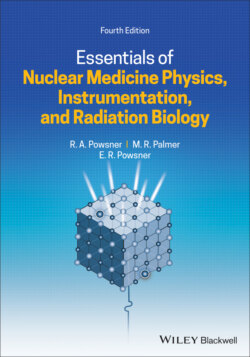Читать книгу Essentials of Nuclear Medicine Physics, Instrumentation, and Radiation Biology - Rachel A. Powsner - Страница 39
Questions
Оглавление1 The chemical interactions between various elements are mainly determined by:The number of protons.The number of neutrons.The number of electrons in the outermost shell.The number of protons minus the number of electrons.
2 For each of the five terms below, choose the best definition:Isobars.Isoclines.Isomers.Isotones.Isotopes.Atoms of the same element (equal Z) with different numbers of neutrons (N).Atoms of the same element (equal Z) with different numbers of protons.Atoms of different elements (different Z) with equal numbers of neutrons (N).Atoms of different elements with equal atomic mass (A).
3 Which of the following statements are correct?There is a stable isotope of technetium.Atoms with atomic numbers (Z) > 83 are inherently unstable.For lighter elements nuclear stability is achieved with equal numbers of protons and neutrons; for heavier elements the number of neutrons exceeds the number of protons.
4 For internal conversion to occur, the excess energy of the excited nucleus must equal or exceed:511 keV.1.022 MeV.The internal conversion coefficient.The average energy of the Auger electrons.The binding energy of the emitted electron.
5 For an atom undergoing beta decay, the average energy of the emitted beta particles is approximately:511 keV.0.551 times the loss of atomic mass.One half of the total energy released for the individual event.One third of the maximum energy of the emitted beta particles.Equal to the average energy of the accompanying antineutrinos.
6 You receive a dose of 99mTc measuring 370 MBq from the radiopharmacy at 10 am. Your patient does not arrive in the department until 2 pm. How much activity, in mCi, remains? (The T1/2 of 99mTc is 6 hours. The constant e = 2.718).
7 Rank the following binding energies from greatest to least:Electron binding energy for outer shell electrons.Nuclear binding energy.Electron binding energy for inner shell electrons.
8 True or false: The term metastable refers to an intermediate state of nuclear decay lasting longer than 10–12 seconds prior to undergoing isomeric transition.
9 Which of the following is true regarding beta decay of a specific radioisotope:The energy of the emitted beta particle is always the same.The energy of the emitted antineutrino is always the same.The summed energy of the emitted beta particle and antineutrino is always the same.
10 Which unit of measurement for radioactivity is defined as one radioactive decay per second?Bequerel.Millicurie.Megabequerel.
11 10 mCi equals how many MBq?2.7 MBq.37 MBq.270 MBq.370 MBq.
12 Lighter nuclides (Z < 83) with an excess of neutrons tend to decay by:Gamma emission.Beta minus decay.Isomeric transition.Positron emission.Alpha emission.
13 Which of the following statements are true?An alpha particle is the same thing as a helium nucleus.Neutrinos have the same charge as an electron.X‐rays always have lower energies than gamma rays.The terms “activity” and “count rate” are the same—they express a measurement of photons per second.
14 When orbital electrons move from an outer shell to an inner‐shell, which of the following is not trueCharacteristic X‐rays can be emitted.Auger electrons can be emitted.The atom becomes more stable.A mixture of gamma rays and internal conversion electrons can be emitted.
